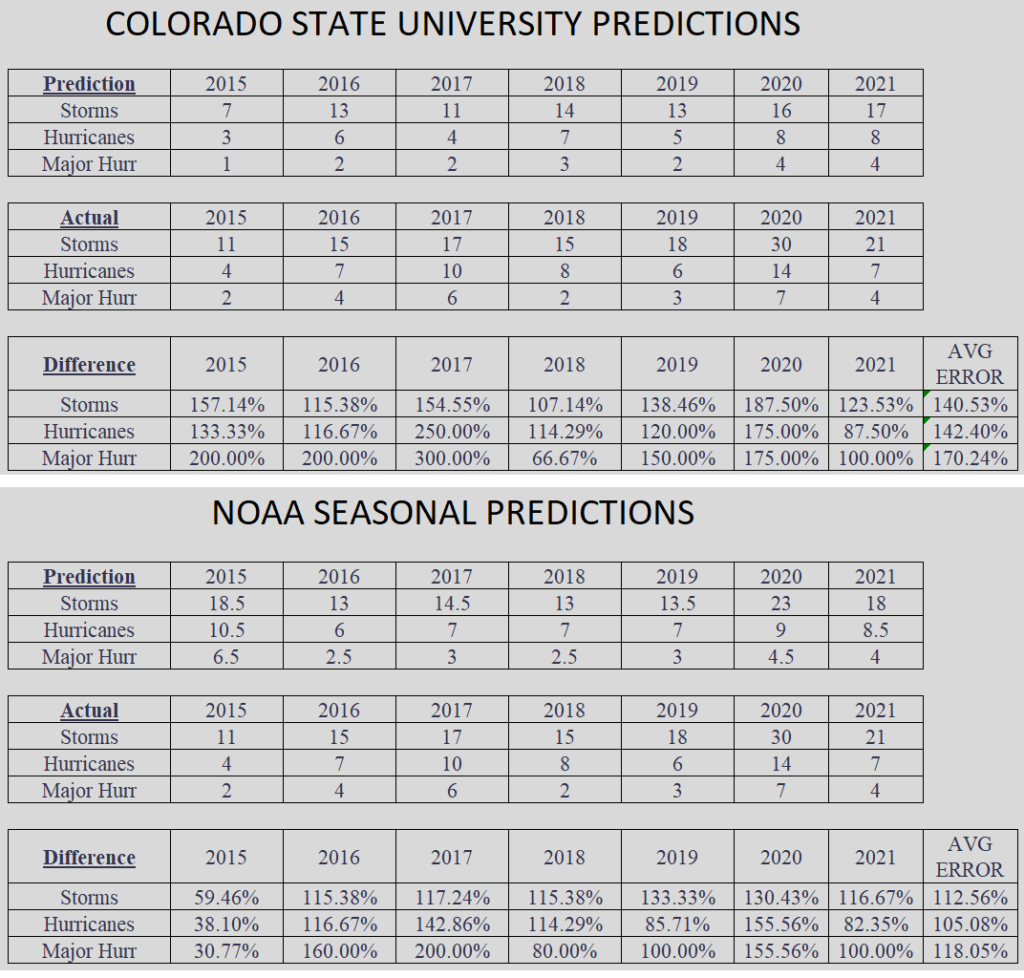NOAA released their 2022 Hurricane season outlook today calling for an above-average season. This should come as no surprise. In the heels of the last few years, the lingering La Nina and the Colorado State prediction, all signs were pointing toward NOAA calling for an “above normal” season.

NOAA is suggesting a season that could feature up to 150% of the normal number of named storms. Up to 10 Hurricanes and up to six Major Hurricanes.
While early season predictions are difficult, you can ask, “How successful have these predictions been during the last few years?”

The Hurricane Season outlook numbers game
It turns out these early season projections are not that great. But it isn’t that the forecasters are over-predicting. They are more often than not under-forecasting the season. That means the eventual number of systems, named storms, hurricanes and major hurricanes is higher than the forecast.
Looking back at the last seven years of data, the Colorado State forecast and the NOAA forecast often miss by at least a few storms. Some years are worse than others, but nearly every year the final tally was higher than the forecast.

And while it could be argued that occasionally during the hurricane season storms get named when they don’t appear to have the qualifications, even subtracting one or two storms per year still leaves many years under-forecast,
And in fact, we can use this to play some fun math games to see if we can unravel some extra info! If you run the numbers, comparing the early-season bias against the final tally of systems during the last seven years, you get an average error of well over 100-percent.
So we can compare that to the early season predictions and make our own ‘bias-corrected’ forecast. That is we can take the forecast from this year and use the error from past forecasts to “fix” the predictions for this year.
This isn’t a true “Fix” but rather just a way to play around with the numbers. If you take the numbers in the outlooks and multiply them by the error, you get the following “bias corrected forecast” for this season…
| OUTLOOKS | NOAA | COLORADO STATE |
| NAMED STORMS | 19.1 | 26.7 |
| HURRICANES | 8.4 | 12.8 |
| MAJOR HURRICANES | 5.3 | 6.8 |
Those numbers are well-above normal.
We can go on step further, too. Since you can’t have fractional tropical systems, we should probably round-up and round-down.
NOAA: 19 named storms, 8 Hurricanes, and 5 Major Hurricanes
CSU: 27 name storms, 13 Hurricanes, and 7 Major Hurricanes

Whoa. I take back my “fun” math game note above. I would like to replace it with “unfortunate” math game.
Maybe some saving grace here, both of those numbers are well-above the “normal” season. But even “normal” the last few years is higher than “normal” during the past 30 years. The average season since 2015 has featured 18 named storms, eight Hurricane and 4 Major Hurricanes. That puts the NOAA bias-corrected forecast barely above “normal” while the CSU bias-corrected forecast is still well-above.
Okay, so not much help, I know. But I tried.
Hurricane formation statistics
This may actually help! Looking back to 1990 all the way through 2020, I tallied every tropical system in the Atlantic and put together some stats to keep in your back pocket during Hurricane Season as you watch Tropical Waves drift across the open waters of the Atlantic.
This table is broken down with the total number of each type of tropical system along the first row. Then the rest of the rows show you the percentage of Tropical Depressions (TD), Tropical Storms (TS) and Hurricanes (HURR) have strengthened into the next stage.
For example, how many Tropical Depressions have become Major Hurricanes? 19.56-percent.
| Tropical Depressions | Tropical Storms | Hurricanes | Major Hurricanes | ||
| Total | 501 | 436 | 224 | 98 | |
| TD-> | 87.03% | 44.71% | 19.56% | ||
| TS-> | 51.38% | 22.48% | |||
| HUR-> | 43.75% | ||||
Of all of the Major Hurricanes since 1990, only 17 have made landfall. That is just under 20-percent.
That also means, of all of the Tropical Depressions that have formed since 1990, only 3.34-percent of them have turned into landfalling Major Hurricanes.
I hear form a lot of people who get anxiety every time a new Tropical Depression forms, fearing the worst. But know that the likelihood that any single Tropical Depression develops into a landfalling Major Hurricane is about 1 of every 30 Tropical Depressions.
So, even if it may feel like every next Tropical Depression is going to be a Major Hurricane headed toward you, the likelihood of that happening is quite low.
Having a plan
But, a 1-in-30 chance is still not a zero chance, so it is important that you are prepared all hurricane season for dealing with a storm. And dealing with the aftermath, too.
For more Hurricane Preparedness Tips, head on over to the Hurricane Preparedness page!

